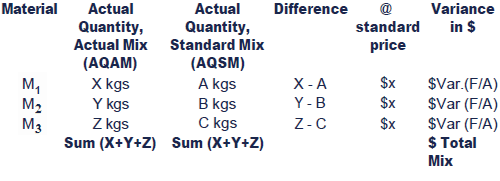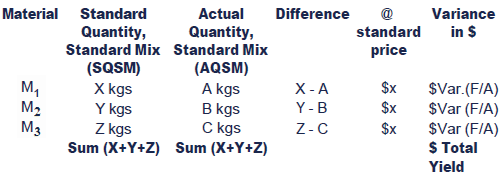Mix and yield variances
When calculating materials variances using variance analysis, one issue that can arise is that a product involves the use of more than one type of material.
If the different materials are not interchangeable, then separate price and usage variances can be calculated. However, if substitution of one material for another can occur, then it is more useful to calculate mix and yield variances.
Mix variances
A mix variance is used to monitor the cost of material. For instance, if more of an expensive material has been used and less of a cheap material, then the overall cost will be higher - and the variance adverse.
Method :
(1) Set up the following table :

(2) Calculate the total of the AQAM column (in kgs, litres, metres etc) and copy the total across to the next 'AQSM' column :

(3) Share this total 'upwards' into the standard mix, which will be given as a proportion in the question or in the standard cost card :

(4) In the 'difference' column, work line by line and find the difference between the AQSM and the AQAM. The total of the difference should be equal to 0. In the last column, multiply the difference by the standard price to get the mix variance.

Yield variances
A yield variance measures the efficiency of turning the inputs into outputs. If the yield variance is adverse, it suggests that actual output is lower than the expected output. This could be due to labour inefficiencies, higher waste, inferior materials, or using a cheaper mix with a lower yield.
Method 1 : The 'total' method

Method 2 : The 'individual' method

'SQSM' is the standard quantity of material used for actual production, shared in the standard mix.
Interpretation of material mix and yield variances
Mix - a favourable total mix variance would suggest that a higher proportion of a cheaper material is being used instead of a more expensive one, hence reducing the overall average cost per unit.
Yield - an adverse total yield variance would suggest that less output has been achieved for a given input, i.e. that the total input in volume is more than expected for the output achieved.
- These variances may be interrelated. A favourable material mix variance may lead to an adverse material yield variance. This is due to differences in quality between the materials used.
- Any change in mix should be judged by the impact on the overall total materials variance.
- The operating statement would include a separate line for each variance.
Changing the mix - the wider issues
It has already been shown that changing the mix of material input can affect the material yield of the process. It can impact on:
- cost
- quality
- performance measurement.
Illustration - Mix and yield: wider issues
A company produces pre-cast concrete sections for the construction industry. The mix of materials used to produce the concrete can be varied and different mixes are suitable for different products. Discuss the issues that management should consider when setting standard material costs.
Solution
For each product management should consider the optimum mix of input materials that will maximise profits to the business. This may involve consideration of:
- the relationship between cost, quality and price. Reducing the cost of input materials by using a greater proportion of a cheaper material may reduce the quality of the product and lead to a reduction in the price that can be charged;
- costs of reduced quality. Using a greater proportion of a cheaper input material may lead to higher quality failure costs;
- impact on other variances. Increasing the proportion of a cheaper input material may result in increased labour costs or overhead costs if this leads to more time having to be spent producing a product. Increased rejects may lead to higher overhead costs.
It may be the case that, whilst changing a material mix could lead to an overall favourable material variance this could have an adverse impact on the profitability of the business if prices have to be reduced because of reduced quality or quality failure costs exceed material cost savings. Thus it is important to set the standard mix at the level which optimises profit taking all factors into consideration.
The control of production processes in manufacturing environments
As well as variances, organisations can also use other performance measures and targets for controlling production processes, e.g.:
- quality measures e.g. reject rate, time spent reworking goods, % waste, % yield
- average cost of inputs
- average cost of outputs
- average prices achieved for finished products
- average margins
- % on-time deliveries
- customer satisfaction ratings.
- detailed time sheets
- % idle time
|
Created at 5/31/2012 10:51 AM by System Account
(GMT) Greenwich Mean Time : Dublin, Edinburgh, Lisbon, London
|
Last modified at 6/11/2014 10:04 AM by System Account
(GMT) Greenwich Mean Time : Dublin, Edinburgh, Lisbon, London
|
|
|
|
 |
Rating
:
|
 Ratings & Comments
(Click the stars to rate the page) Ratings & Comments
(Click the stars to rate the page)
|
 |
Tags:
|
|
|
|
|